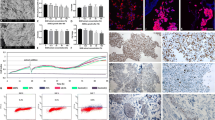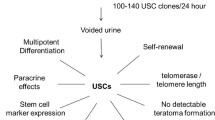Abstract
Ileal conduits are commonly used in bladder cancer treatment and in pediatric patients who require urinary diversion surgeries. We constructed a tissue-engineered conduit using bone marrow mesenchymal stem cells (BMSCs) and a bladder acellular matrix (BAM) and transplanted it into rabbits for urinary diversion to evaluate the feasibility of its clinical application. Rabbit BMSCs were isolated, expanded in vitro, and were then treated with a conditional medium for 3 weeks, allowing the BMSCs to transform into urothelium-like cells. These cells were seeded onto BAM and cultured for another week. The cell-matrix grafts were then sewn into a conduit approximately 4 cm in length and 1 cm in diameter and were implanted as conduits for urinary diversion in 12 male rabbits. Rabbits were sacrificed at 1, 2, and 4 week after operation. Histologic examinations were performed using hematoxylin and eosin staining and tissue structures were evaluated by using immunohistochemistry. BMSCs can transform into urothelium-like cells that express the urothelium-specific proteins uroplakin 1A (UPK1A), cytokeratin 7 (CK7), and cytokeratin 13 (CK13). These cells are able to generate epithelial coverage in the conduit lumen based on BAM. Immunohistochemistry showed positive staining with AE1/AE3, UPK1A, and tight junction protein 1 (ZO-1), indicating the presence of mature and functional epithelial cells on the lumen of the conduit. BMSCs may represent a new source cell for urinary tissue engineering, and it is feasible to construct a conduit with transformed BMSCs and BAM for urinary diversion in rabbits.
Similar content being viewed by others
References
Cho KS, Seo JW, Park SJ, Lee YH, Choi YD, Cho NH, et al. The risk factor for urethral recurrence after radical cystectomy in patients with transitional cell carcinoma of the bladder. Urol Int 2009;82:306–311.
Engelhardt EM, Micol LA, Houis S, Wurm FM, Hilborn J, Hubbell JA, et al. A collagen-poly(lactic acid-co-e-caprolactone) hybrid scaffold for bladder tissue regeneration. Biomaterials 2011;32:3969–3976.
Vasdev N, Moon A, Thorpe AC. Metabolic complications of urinary intestinal diversion. Indian J Urol 2013;29:310–315.
Hensle TW, Gilbert SM. A review of metabolic consequences and longterm complications of enterocystoplasty in children. Curr Urol Rep 2007;8: 157–162.
McDougal WS. Metabolic complications of urinary intestinal diversion. J Urol 1992;147:1199–1208.
Smith JA Jr. Mucus production after transposition of intestinal segments into the urinary tract. J Urol 2005;174:1860–1861.
Riddick AC, Turner WH, Mills RD. Bowel function after urinary diversion. World J Urol 2004;22:210–214.
Song JJ, Ott HC. Organ engineering based on decellularized matrix scaffolds. Trends Mol Med 2011;17:424–432.
Liao WB, Song C, Li YW, Yang SX, Meng LC, Li XH. Tissue-engineered conduit using bladder acellular matrix and bladder epithelial cells for urinary diversion in rabbits. Chin Med J (Engl) 2013;126:335–339.
Li CL, Liao WB, Yang SX, Song C, Li YW, Xiong YH, et al. Urethral reconstruction using bone marrow mesenchymal stem cell-and smooth muscle cell-seeded bladder acellular matrix. Transplant Proc 2013;45:3402–3407.
Sykova E, Forostyak S. Stem cells in regenerative medicine. Laser Ther 2013;22:87–92.
Tian H, Bharadwaj S, Liu Y, Ma PX, Atala A, Zhang Y. Differentiation of human bone marrow mesenchymal stem cells into bladder cells: potential for urological tissue engineering. Tissue Eng Part A 2010;16:1769–1779.
Tian H, Bharadwaj S, Liu Y, Ma H, Ma PX, Atala A, et al. Myogenic differentiation of human bone marrow mesenchymal stem cells on a 3D nano fibrous scaffold for bladder tissue engineering. Biomaterials 2010;31:870–877.
Liao W, Yang S, Song C, Li X, Li Y, Xiong Y. Construction of ureteral grafts by seeding bone marrow mesenchymal stem cells and smooth muscle cells into bladder acellular matrix. Transplant Proc 2013;45:730–734.
Yang SX, Shen FJ, Hu YF, Jin HM, Wang LL. Experimental bladder defect in rabbit repaired with homologous bladder extracellular matrix graft. Chin Med J (Engl) 2005;118:957–960.
Liao W, Yang S, Song C, Li Y, Meng L, Li X, et al. Tissue-engineered tubular graft for urinary diversion after radical cystectomy in rabbits. J Surg Res 2013;182:185–191.
Wolff EM, Liang G, Jones PA. Mechanisms of Disease: genetic and epigenetic alterations that drive bladder cancer. Nat Clin Pract Urol 2005; 2:502–510.
Ning J, Li C, Li H, Chang J. Bone marrow mesenchymal stem cells differentiate into urothelial cells and the implications for reconstructing urinary bladder mucosa. Cytotechnology 2011;63:531–539.
Zhang Y, Atala A. Urothelial cell culture: stratified urothelial sheet and three-dimensional growth of urothelial structure. Methods Mol Biol 2013; 945:383–399.
Jacob AM, Gaver DP 3rd. Atelectrauma disrupts pulmonary epithelial barrier integrity and alters the distribution of tight junction proteins ZO-1 and claudin 4. J Appl Physiol (1985) 2012;113:1377–1387.
Acharya P, Beckel J, Ruiz WG, Wang E, Rojas R, Birder L, et al. Distribution of the tight junction proteins ZO-1, occludin, and claudin-4,-8, and-12 in bladder epithelium. Am J Physiol Renal Physiol 2004;287:F305–F318.
Yuan H, Zhuang Y, Xiong J, Zhi W, Liu L, Wei Q, et al. Human umbilical mesenchymal stem cells-seeded bladder acellular matrix grafts for reconstruction of bladder defects in a canine model. PLoS One 2013;8:e80959.
Cheng HL, Loai Y, Beaumont M, Farhat WA. The acellular matrix (ACM) for bladder tissue engineering: a quantitative magnetic resonance imaging study. Magn Reson Med 2010;64:341–348.
Antoon R, Yeger H, Loai Y, Islam S, Farhat WA. Impact of bladder-derived acellular matrix, growth factors, and extracellular matrix constituents on the survival and multipotency of marrow-derived mesenchymal stem cells. J Biomed Mater Res A 2012;100:72–83.
Leite MT, Freitas-Filho LG, Oliveira AS, Semedo-Kuriki P, Laks M, Arias VE, et al. The use of mesenchymal stem cells in bladder augmentation. Pediatr Surg Int 2014;30:361–370.
Geutjes P, Roelofs L, Hoogenkamp H, Walraven M, Kortmann B, de Gier R, et al. Tissue engineered tubular construct for urinary diversion in a preclinical porcine model. J Urol 2012;188:653–660.
Zhao Z, Yu H, Xiao F, Wang X, Yang S, Li S. Differentiation of adipose-derived stem cells promotes regeneration of smooth muscle for ureteral tissue engineering. J Surg Res 2012;178:55–62.
Wu R, Liu G, Bharadwaj S, Zhang Y. Isolation and myogenic differentiation of mesenchymal stem cells for urologic tissue engineering. Methods Mol Biol 2013;1001:65–80.
Wu R, Liu G, Bharadwaj S, Zhang Y. Isolation and myogenic differentiation of mesenchymal stem cells for urologic tissue engineering. Methods Mol Biol 2013;1001:65–80.
Author information
Authors and Affiliations
Corresponding author
Rights and permissions
About this article
Cite this article
Xiong, Y., Liao, W., Yang, S. et al. A tissue-engineered conduit for urinary diversion using bone marrow mesenchymal stem cells and bladder acellular matrix. Tissue Eng Regen Med 12, 188–194 (2015). https://doi.org/10.1007/s13770-015-0115-2
Received:
Revised:
Accepted:
Published:
Issue Date:
DOI: https://doi.org/10.1007/s13770-015-0115-2




